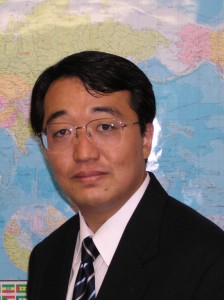緊張と統合:内村鑑三におけるキリスト教と日本の精神
このシリーズでは、私が1994年に執筆した統一神学大学院(Unification Theological Seminary)の神学課程修士論文(Divinity Thesis)を日英二か国語で掲載している。
6.無教会と日本社会の続き
しかしながら、表面的には西洋から多くのものを取り入れながらも、日本の政治的、社会的組織の構造とそのイデオロギーとは実質的には保存されていた。キリスト教を受け入れることは、必ずしも西洋の技術と物質主義を享受するために必要ではないことを、日本人は悟りはじめたのである。日本の近代化は家族主義的かつ権威主義的な政府によって着手され、それは神道を国家宗教として復興させようとしていた。明治政府の目的は、古代の祭政一致の原理と神政主義国家を復活させることであった。明治憲法の主要な草案者である伊藤博文は、日本にはヨーロッパにおけるキリスト教のような強力な宗教が存在しないので、皇室が国民の精神的統合の核となるべきであると主張した。政府は仏教と深く結びついていた神道をそこから引き離し、神道を新しい日本に上から乗せるべく、神祗官を設立した。
政府が不本意ながら西欧諸国の圧力に屈し、基督教禁止令を撤廃する決断をしたことは、徳川時代に反切支丹政策を続行する任務をまかされていた仏教徒の感情に衝撃を与えた。そこで仏教徒達は、信教の自由を支持していた者達も含めて、神道、儒教、および国粋主義の指導者達と同盟して、「破邪顕正」と呼ばれる反キリスト教運動を形成したのである。
儒教側も、新政府が西洋のモデルに従って教育システムを組織し、伝統ある重要な儒学を犠牲にして洋学を歓迎する政策に対して、恨みを抱いていた。しかし10年ほどの西洋化の後、その反動としての保守主義的な風潮が儒教の力をも復興させた。教育勅語が発布され、「修身」が学校制度に強制的に採用されることによって、儒教の徳目である孝と忠が教化され、日本古来の道徳的価値観として提示されるようになった。このようにして、この時から第二次世界大戦が終わるまでの期間、「非宗教的」儒教倫理が、「超宗教的」国家神道を支えるようになったのである。
このような公と個人における信仰実践の区別は、法律においては明確に分離されていたが、日本における宗教的実践の現実とはうまく符合しなかった。明治憲法において信教の自由は文字の上では保証されていたが、それは「安寧秩序ヲ妨ゲズ・及臣民タル義務ニ背カザル限リニ於テ」という限定付きであった。信教の自由の意味は、教育勅語が発布された後にはより狭い意味で解釈されるようになり、教育勅語は戦前の日本における倫理道徳の柱となった。反キリスト教グループの主唱者達は、キリスト教の普遍的な愛の教義は、勅語において明確に教えられている忠と孝の国家的な徳目と相容れないものであると強調した。このようにキリスト教とその価値体系は、国体と相反するものであるとみなされた。その一神教的信仰は皇室の敵であるとみなされ、したがって天皇に対する忠誠を教える神道は、反キリスト教の強力な中心となったのである。このような状況の故に、困難は増大し、教会の成長も停滞する時期が始まったのである。
VI. Mukyokai and Japanese Society. (Cont.)
However, while superficially taking over much from the west, the main structure of Japan’s political and social institutions and her ideologies were substantially preserved.(5)Japanese began to realize that acceptance of Christianity was not indispensable for enjoying western technology and materialism.(6)The modernization of Japan was initiated by a paternalistic, authoritarian government, which attempted to revitalize Shinto as the national religion. The aim of the Meiji regime was to restore the ancient principle of the unity of religion and government and the immanental theocratic state. Hirobumi Ito (1841-1909), the chief architect of the Meiji Constitution, insisted that the imperial house must be the core of people’s spiritual unity and national loyalty, because there is no such strong religion in Japan as Christianity in Europe.(7)The government separated Shinto from its close affiliation with Buddhism, and the department of Shinto was established to superimpose Shinto on the new Japan.
The government’s reluctant decision to surrender to the pressure of Occident powers and lift the ban against Christianity was an emotional blow to Buddhism, which had been charged with the task of carrying out the anti-Kirishitan policy of the Tokugawa regime. Thus, many Buddhists, including those who had supported religious freedom, allied themselves with Shinto, Confucian, and nationalist leaders in an emotional anti-Christian campaign called haja kensei (“refutation of evil religion and the exaltation of righteous religion”).(8)
Confucians also resented the new regime’s policy of organizing the educational system on Western models and welcoming Western learning (yogaku) at the expense of traditional important Confucian learning (jugaku). After a decade of westernization, however, a reactional conservative mood revived the power of Confucians also. With the promulgation of the Imperial Rescript on Education and the adoption of compulsory “moral teaching” (shushin) in school systems, Confucian virtues of filial piety and loyalty were domesticated and presented as indigenous moral values. As such, “nonreligious” Confucian ethics supported “super-religious” State Shinto until the end of World War II.(9)
This distinction between the private and public exercise of religious faith was clear-cut in law, but did not conform well to the reality of Japanese religious practice.(10) Although religious freedom was nominally guaranteed in the Meiji Constitution, it was limited to the extent that is “not prejudicial to peace and order, and not antagonistic to their duties as subjects.” The understanding of religious freedom was interpreted more narrowly after the promulgation of the Imperial Rescript on Education, which became the pillar of prewar Japan’s ethics and morality. Spokesmen of anti-Christian groups stressed that the Christian doctrine of universal love was incompatible with the national virtues of loyalty and filial piety taught explicitly in the Rescript. Thus, Christianity and its value systems were regarded as being inconsistent with national polity (kokutai). Its monotheistic faith was regarded as an enemy of the Imperial Family, thus Shinto, which taught loyalty to the emperor, became an intense center of opposition.(11) Because of this situation、period of increasing difficulties and slow progress had begun.(12)
(5)Kenneth Scott Latourette, The Great Century: In Africa and Asia, A.D. 1800 – A.D. 1914. vol. VI of A History of the Expansion of Christianity, (Grand Rapids, Michigan, Zondervan Publishing House, 1970), p.371.
(6)op cit, Thomas, p.190.
(7)Masayuki Suzuki, Koushitsu Seido [The System of the Imperial Household], (Tokyo: Iwanami Shoten, 1993), p.91.
(8)op cit, Thomas, p.197.
(9)The Encyclopedia of Religion, 1987 ed., s.v. “Japanese Religion: An Overview” by Joseph M. Kitagawa.
(10)op cit, Hardacre, p.121.
(11)op cit, Thomas, p.184.
(12)op cit, Ebisawa and Ouchi, p.296.

